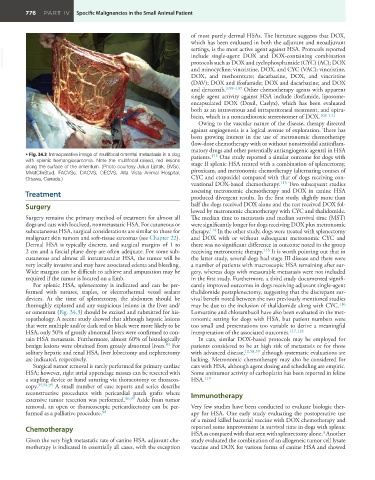Page 798 - Withrow and MacEwen's Small Animal Clinical Oncology, 6th Edition
P. 798
776 PART IV Specific Malignancies in the Small Animal Patient
of most purely dermal HSAs. The literature suggests that DOX,
which has been evaluated in both the adjuvant and neoadjuvant
settings, is the most active agent against HSA. Protocols reported
VetBooks.ir include single-agent DOX and DOX-containing combination
protocols such as DOX and cyclophosphamide (CYC) (AC); DOX
and minocycline; vincristine, DOX, and CYC (VAC); vincristine,
DOX, and methotrexate; dacarbazine, DOX, and vincristine
(DAV); DOX and ifosfamide; DOX and dacarbazine; and DOX
and deracoxib. 3,99–107 Other chemotherapy agents with apparent
single agent activity against HSA include ifosfamide, liposome-
encapsulated DOX (Doxil, Caelyx), which has been evaluated
both as an intravenous and intraperitoneal treatment, and epiru-
bicin, which is a noncardiotoxic stereoisomer of DOX. 108–111
Owing to the vascular nature of the disease, therapy directed
against angiogenesis is a logical avenue of exploration. There has
been growing interest in the use of metronomic chemotherapy
(low-dose chemotherapy with or without nonsteroidal antiinflam-
matory drugs and other potentially antiangiogenic agents) in HSA
• Fig. 34.3 Intraoperative image of multifocal omental metastasis in a dog patients. 112 One study reported a similar outcome for dogs with
with splenic hemangiosarcoma. Note the multifocal raised, red lesions stage II splenic HSA treated with a combination of splenectomy,
along the surface of the omentum. (Photo courtesy Julius Liptak, BVSc, piroxicam, and metronomic chemotherapy (alternating courses of
MVetClinStud, FACVSc, DACVS, DECVS, Alta Vista Animal Hospital,
Ottawa, Canada.) CYC and etoposide) compared with that of dogs receiving con-
ventional DOX-based chemotherapy. 113 Two subsequent studies
Treatment assessing metronomic chemotherapy and DOX in canine HSA
produced divergent results. In the first study, slightly more than
Surgery half the dogs received DOX alone and the rest received DOX fol-
lowed by metronomic chemotherapy with CYC and thalidomide.
Surgery remains the primary method of treatment for almost all The median time to metastasis and median survival time (MST)
dogs and cats with localized, nonmetastatic HSA. For cutaneous or were significantly longer for dogs receiving DOX plus metronomic
subcutaneous HSA, surgical considerations are similar to those for therapy. 114 In the other study, dogs were treated with splenectomy
malignant skin tumors and soft-tissue sarcomas (see Chapter 22). and DOX with or without subsequent metronomic CYC and
Dermal HSA is typically discrete, and surgical margins of 1 to there was no significant difference in outcome noted in the group
2 cm and a fascial plane deep are often adequate. For some sub- receiving metronomic therapy. 115 It is worth pointing out that in
cutaneous and almost all intramuscular HSA, the tumor will be the latter study, several dogs had stage III disease and there were
very locally invasive and may have associated edema and bleeding. a number of patients with macroscopic HSA remaining after sur-
Wide margins can be difficult to achieve and amputation may be gery, whereas dogs with measurable metastasis were not included
required if the tumor is located on a limb. in the first study. Furthermore, a third study documented signifi-
For splenic HSA, splenectomy is indicated and can be per- cantly improved outcomes in dogs receiving adjuvant single-agent
formed with sutures, staples, or electrothermal vessel sealant thalidomide postsplenectomy, suggesting that the discrepant sur-
devices. At the time of splenectomy, the abdomen should be vival benefit noted between the two previously mentioned studies
thoroughly explored and any suspicious lesions in the liver and/ may be due to the inclusion of thalidomide along with CYC. 116
or omentum (Fig. 34.3) should be excised and submitted for his- Lomustine and chlorambucil have also been evaluated in the met-
topathology. A recent study showed that although hepatic lesions ronomic setting for dogs with HSA, but patient numbers were
that were multiple and/or dark red or black were more likely to be too small and presentations too variable to derive a meaningful
HSA, only 50% of grossly abnormal livers were confirmed to con- interpretation of the associated outcomes. 117,118
tain HSA metastasis. Furthermore, almost 60% of histologically In cats, similar DOX-based protocols may be employed for
benign lesions were obtained from grossly abnormal livers. For patients considered to be at high risk of metastasis or for those
93
solitary hepatic and renal HSA, liver lobectomy and nephrectomy with advanced disease, 11,58,59 although systematic evaluations are
are indicated, respectively. lacking. Metronomic chemotherapy may also be considered for
Surgical tumor removal is rarely performed for primary cardiac cats with HSA, although agent dosing and scheduling are empiric.
HSA; however, right atrial appendage masses can be resected with Some antitumor activity of carboplatin has been reported in feline
a stapling device or hand suturing via thoracotomy or thoracos- HSA. 119
copy. 35,94,95 A small number of case reports and series describe
reconstructive procedures with pericardial patch grafts where Immunotherapy
extensive tumor resection was performed. 96,97 Aside from tumor
removal, an open or thoracoscopic pericardiectomy can be per- Very few studies have been conducted to evaluate biologic ther-
98
formed as a palliative procedure. apy for HSA. One early study evaluating the postoperative use
of a mixed killed bacterial vaccine with DOX chemotherapy and
Chemotherapy reported some improvement in survival time in dogs with splenic
HSA as compared with that seen with splenectomy alone. Another
3
Given the very high metastatic rate of canine HSA, adjuvant che- study evaluated the combination of an allogeneic tumor cell lysate
motherapy is indicated in essentially all cases, with the exception vaccine and DOX for various forms of canine HSA and showed

